Rainforest Wild Asia in Mandai opens on March 12; visitors can opt for guided adventure tours
Sign up now: Get ST's newsletters delivered to your inbox

Tickets to the fifth wildlife park by Mandai Wildlife Group are now available for sale on its website.
ST PHOTOS: LIM YAOHUI
Follow topic:
SINGAPORE - Wildlife lovers who are also thrill seekers will soon get a taste of both worlds when Rainforest Wild Asia opens on March 12.
As visitors explore the park – either through wide elevated walkways or via more rugged terrain at ground level – they will get a glimpse of what it would be like to hike through a South-east Asian rainforest featuring the region’s rich biodiversity.
For an extra side of adventure in what is dubbed by Mandai Wildlife Group as Asia’s first adventure-based zoological park, adrenaline junkies can pay additional fees to join three-hour-long guided adventure tours, or activities such as free-falling from a platform or crawling through a dim cave tunnel.
Tickets to the fifth wildlife park by Mandai Wildlife Group are now available for sale on its website, with discounted tickets for local residents until March 31 to celebrate its opening, said the group on Feb 12.
Admissions until March 31 will cost $33 for an adult and $21 per child for those aged three to 12, while seniors aged 60 and above will be charged $20.
From April 1, visitors will pay the full price of $43 for an adult and $31 for a child. The ticket price for senior citizens will remain at $20.
The park will open daily from 9am to 6pm, with last admission at 5pm.
The other parks in Mandai’s stable of wildlife parks are the Singapore Zoo, Night Safari, River Wonders and Bird Paradise.
The new Rainforest Wild will open in phases. The first phase to open is Rainforest Wild Asia, which will feature zones shaped after different layers of the rainforest.
The next phase is Rainforest Wild Africa, which is inspired by the landscapes of the afro-tropical region and Madagascar. There are no details yet on when this phase will open.
At 13ha, or about the size of 20 football fields, Rainforest Wild Asia is currently the second smallest of the five parks.
The smallest is River Wonders at 12ha, while the largest is the Singapore Zoo which spans 26ha.

The park will open daily from 9am to 6pm, with last admission at 5pm.
ST PHOTO: LIM YAOHUI
Ms Maggie Ang, vice-president for park operations at Mandai, said the group is hoping to welcome 900,000 guests to the new park in its first year of operations.
Rainforest Wild Asia will be home to 36 species, including Malayan tigers, Javan langurs and lesser mousedeer.
It will also house species new to Singapore such as the Francois’ langur and Philippine spotted deer, which are both endangered.
“We live in one of the world’s most biodiverse regions, but many of the region’s species are under threat due to the loss of wild habitats and the negative impact of pollution,” said Mr Mike Barclay, group chief executive of Mandai Wildlife Group.
“With the belief that you can’t protect what you don’t know, we want to raise awareness about the region’s incredible wildlife species by shining a spotlight on them in this park.”
None of the animals at the new park was sourced from wild populations, Mandai Wildlife Group said.
Some of them, such as the Malayan tigers, came from the existing Mandai parks, where they were born. Mandai also receives animals from other zoological institutions through more than 160 internationally managed species programmes to help save threatened species. These include the Francois’ langur.
Featuring different layers of the rainforest, from cavern to canopy, Rainforest Wild Asia has 7,000 South-east Asian trees and shrubs planted to supplement the existing protected patches of rainforest.
Over 320 mature trees were preserved from the original site, which was a secondary forest plot.

Rainforest Wild Asia has 7,000 South-east Asian trees and shrubs planted to supplement the existing protected patches of rainforest.
ST PHOTO: LIM YAOHUI
The park is split into eight zones of open-concept habitats, such as karst formations and a cave.
Such an immersive design allows visitors to see how different animals thrive in distinct rainforest settings, in a bid to create strong feelings of connection to nature and determination to protect the planet, Mandai Wildlife Group said.
The habitats were designed with a setback distance from public areas to create an additional buffer, which reduces the likelihood of animals reaching the perimeter.
The perimeter also features smooth, unclimbable walls that help keep the animals within the habitat.
Visitors can stroll along wheelchair-friendly walkways, explore forest trails closer to the ground which require crossing over logs and streams, or go higher up near the canopy where they can climb, jump and abseil in safety harnesses.

The Wild Apex Adventure tour will take participants through an aerial adventure in the Karst and Canopy habitats where they can climb metal rungs, ladders and suspended bridges.
ST PHOTO: LIM YAOHUI
Occasionally, visitors may also cross paths with animals such as langurs and deer. Along some treks, lucky visitors may even walk alongside Malayan tigers as the animals pass through walkways in their own habitat.
Some of the highlights include The Karsts, where visitors can watch the Francois’ langurs swinging and leaping around the habitat, which is filled with jagged limestone formations.

Visitors can watch the Francois’ langurs swinging and leaping at the Karsts, which has jagged limestone formations.
ST PHOTO: LIM YAOHUI
Over at the Watering Hole, which is the largest zone in the park, visitors can spot the Malayan tapir on the forest floor or the Malayan sun bear foraging among the trees.
Visitors can also see Malayan tigers – two of which were born at the Night Safari – at the Rock Cascade, and the Javan langur and red-shanked douc langur at The Canopy.
The park will also feature cave chambers called The Cavern, which are inspired by the Mulu Caves, a Unesco World Heritage site in Sarawak, Malaysia.
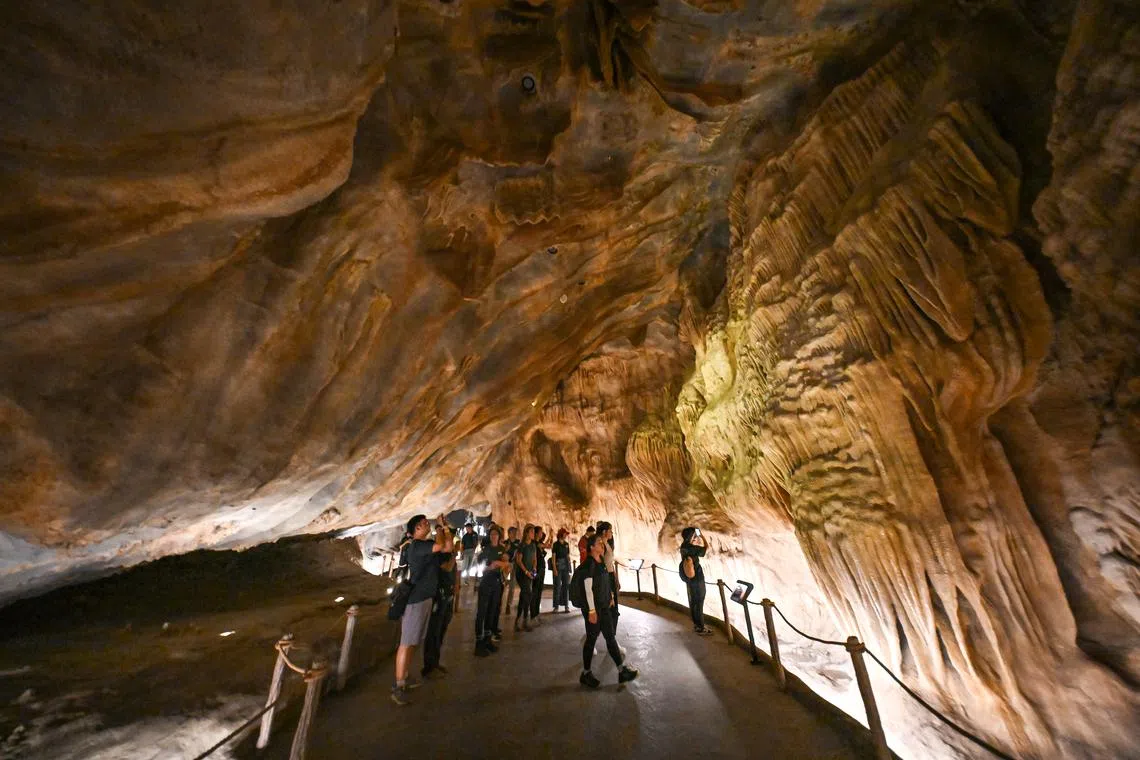
The Cavern is inspired by the Mulu Caves, a Unesco World Heritage Site in Sarawak, Malaysia.
ST PHOTO: LIM YAOHUI
Most zones will also have ranger talks where keepers will share more about the animals dwelling in the different zones, such as their characteristics, as well as conservation efforts for the endangered species.
To spice things up, thrill seekers can pay an extra fee for three activities, such as the Canopy Jump, where visitors can step off a 13m or 20m platform for a simulated free fall, and the AIA Vitality Bounce, which has three open-sky bounce zones at least 3m above ground.
At Critter Crawl, participants have to crouch or even crawl through a 60m dark cave tunnel with stalactites and fossil imprints and look over cockroaches through a glass floor panel.
Those looking to get out of their comfort zone can join two guided three-hour harnessed tours, which take participants to areas not accessible to the public.

Visitors can explore forest trails closer to the ground, which require crossing over logs and streams.
ST PHOTO: LIM YAOHUI
The Wild Apex Adventure tour will take participants through an aerial adventure in the Karst and Canopy habitats where they can climb metal rungs, ladders and suspended bridges, while taking in views of the Mandai Wildlife Reserve and Langur Island habitat below.
Participants on the Wild Cavern Adventure tour will get to abseil in the dark with only their headlights illuminating the caves and squeeze through tight spaces as they explore the nooks and crannies of the cavern system.
Each tour, which includes admission and a photo, costs $192 for an adult, $182 for a child and $172 for a senior citizen.
There will be four food and beverage outlets, including Singapore’s first and only restaurant in a cave setting and a food hall featuring South-east Asian food.
Members of the public can pre-book their admission tickets and any add-on programmes from Feb 12 at www.mandai.com
Features of Rainforest Wild Asia
Entrance Gorge
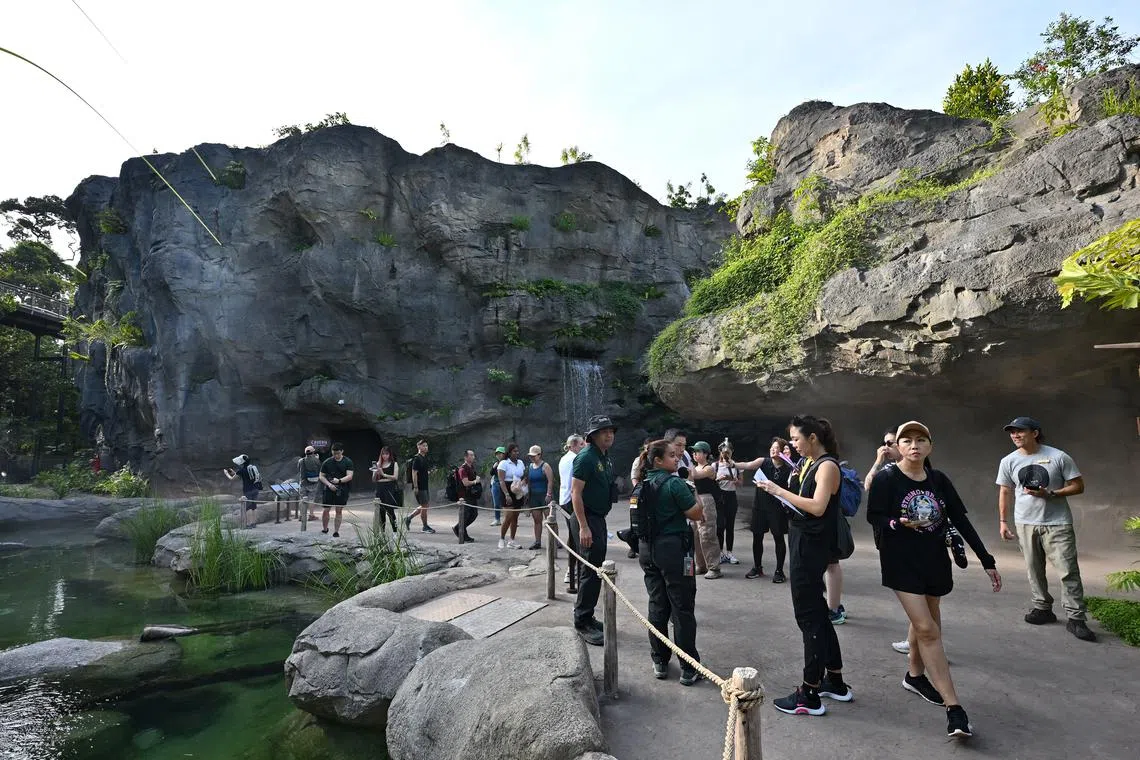
The Entrance Gorge.
ST PHOTO: LIM YAOHUI
Mimics the edge of a natural rainforest, with emergent trees
Houses freshwater species such as the Asian arowana and Southern river terrapin in the habitat pond
The Karsts
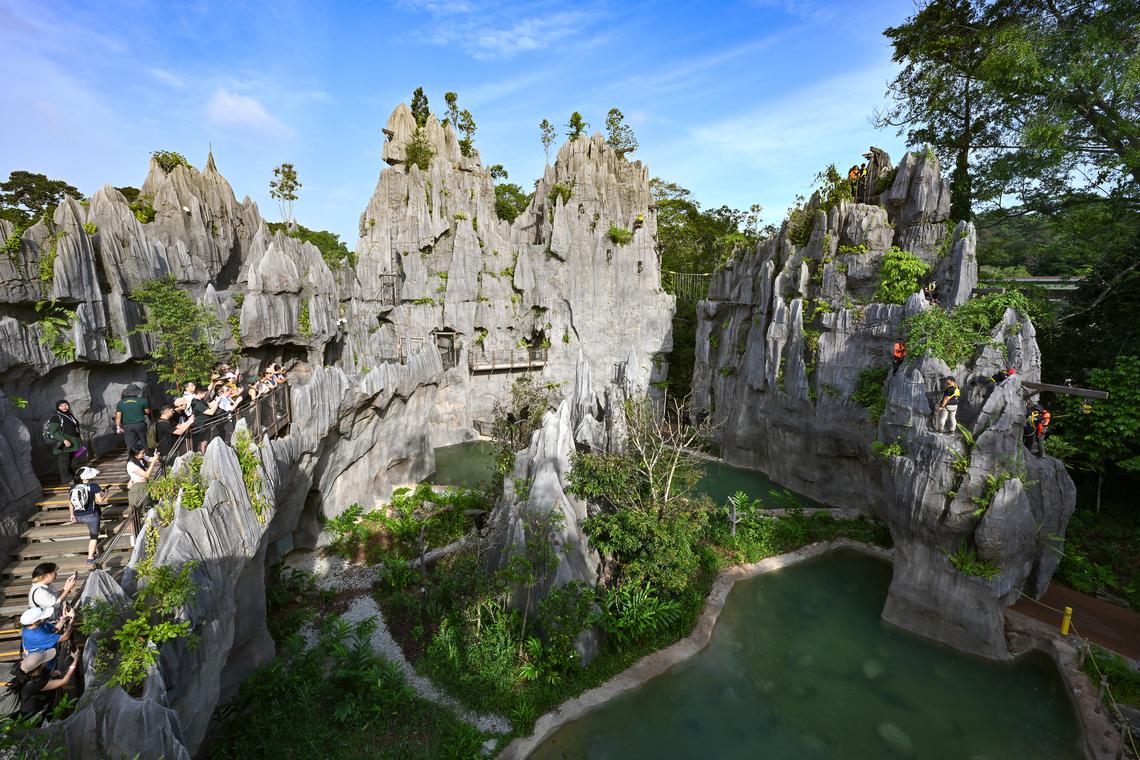
The Karsts.
ST PHOTO: LIM YAOHUI
Jagged limestone formations peek through the rainforest canopy, creating one of the park’s most scenic backdrops
Agile Francois’ langurs, one of the world’s rarest monkeys, can be seen swinging and leaping here
Forest Floor
Recreates the rich, nutrient-dense environment that sustains the rainforest
Has boulder steps, fallen trees and a root tunnel to climb and navigate
Hog deer, lesser mousedeer and Asian brown tortoises, among other species, can be spotted here
The Outpost
Provides a rest stop where visitors can grab a quick bite at Rangers Cafe
Houses the park’s camping ground, which can fit 20 dome tents and offers facilities such as a classroom and shower areas
More details on camping programmes will be rolled out later
Rock Cascade
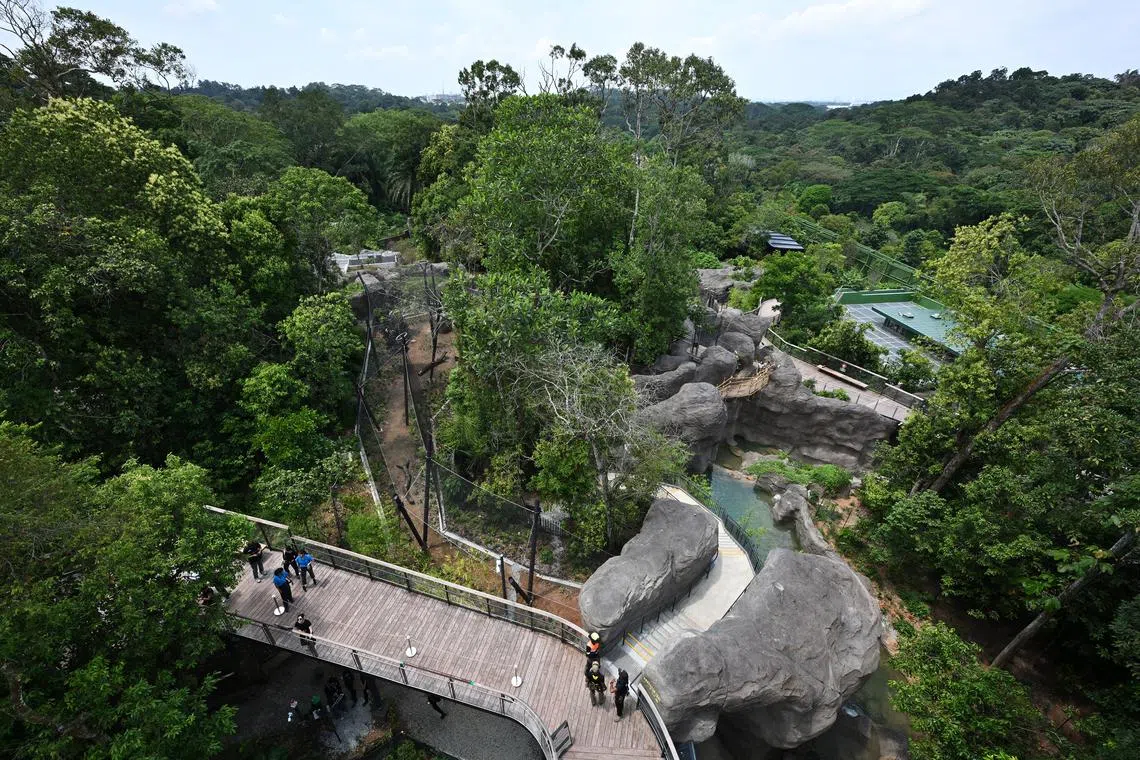
The Rock Cascade.
ST PHOTO: LIM YAOHUI
Features different types of vegetation landscapes, from tall grasses and bamboo groves to majestic trees
Main elevated walkway above the forest floor lets visitors watch Malayan tigers wander through tunnels, rocky formations and cascading waterfalls
Houses two of three flexible habitats, which exhibit different predator and prey species at various times of the day. Predators include the red dholes, which are Asian wild dogs, while prey include the bearded pig
The Canopy
Offers a glimpse of life at the tree tops where mature trees make up the rich canopy environment
Visitors may chance upon species of primates such as the Javan langur, red-shanked douc langur and siamang
They can use the 180 sq m Langur Walking Nets to feel like a langur suspended high above the ground while looking down at the forest floor to spot the endangered Philippine spotted deer
Watering Hole
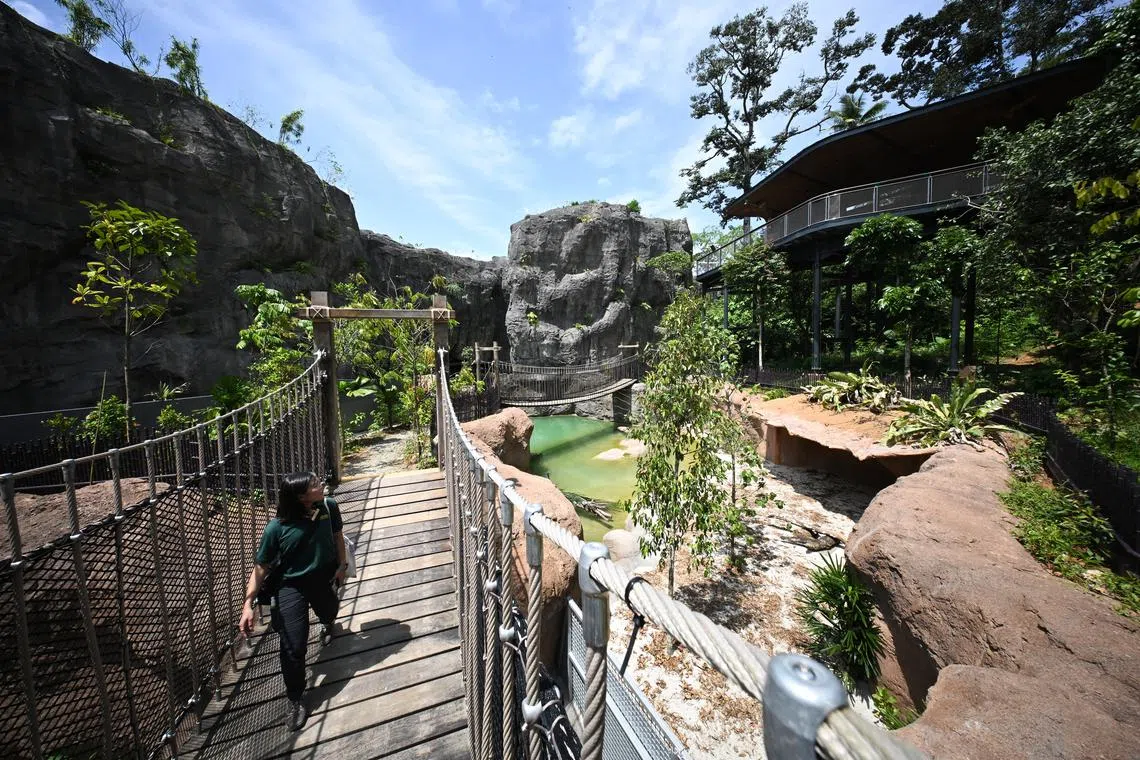
The Watering Hole.
ST PHOTO: LIM YAOHUI
Largest zone in the park showcases the vital role water plays in the ecosystem
Among the highlights are the Malayan tapir, which may be found roaming the forest floor, or the Malayan sun bear, which can be seen foraging among the trees
Meandering elevated walkways culminate in a crocodile pond with suspended bridges for visitors to cross
The Cavern
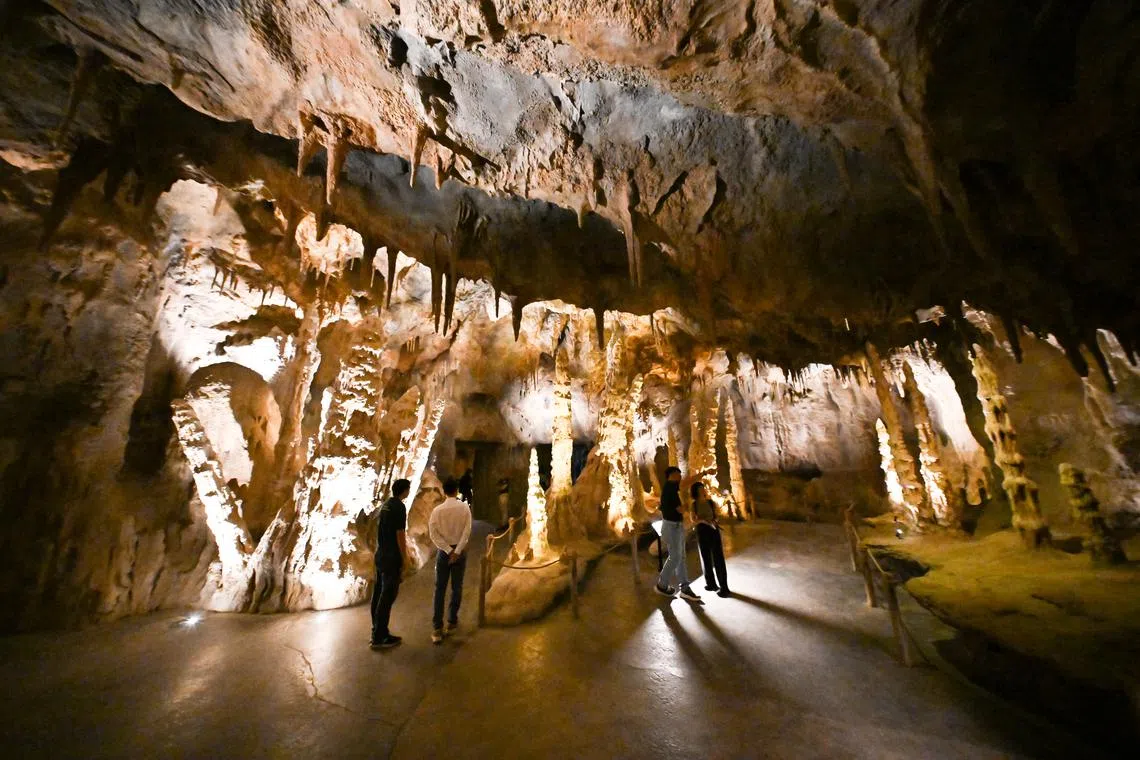
Visitors can explore cave chambers and rock formations in a cooler setting at The Cavern.
ST PHOTO: LIM YAOHUI
A 220m cavern inspired by Mulu Caves, a Unesco World Heritage Site in Sarawak, Malaysia
Visitors can explore cave chambers and rock formations in a cooler setting
Madagascar hissing cockroaches, soro brook carp, the Malayan cave racer and Asian black scorpion are among the species seen here
The light at the end of the tunnel signals the end of the visit, literally, as the oculus lets sunlight into the dark cavern
Add-on experiences: Thrill-seekers can pay for three adrenaline-inducing activities. Bookings are required.
Canopy Jump: Step off a 13m or 20m platform for a simulated free fall while taking in stunning vistas of the rainforest.

Step off a 13m or 20m platform for a stimulated free fall while taking in stunning vistas of the rainforest at the Canopy Jump.
ST PHOTO: LIM YAOHUI
AIA Vitality Bounce: Bounce around three open-sky bounce zones at least 3m above the ground.

Bounce around three open-sky bounce zones at least 3m above the ground at the AIA Vitality Bounce.
ST PHOTO: LIM YAOHUI
Critter Crawl: Crouch, or even crawl, through a dark 60m cave tunnel with stalactites and fossil imprints while cockroaches are seen below, under a glass floor panel.
Guided adventure tours: Those looking to get out of their comfort zone can join two guided three-hour harnessed tours, which take participants to areas not accessible to the public.
Wild Apex Adventure tour: Move along The Karsts by climbing metal rungs, ladders and suspended bridges, while taking in views of the Mandai Wildlife Reserve and Langur Island habitat below. Afterwards, hike to The Canopy and walk along planks suspended about 9m above ground to the Langur Observation Deck.
Wild Cavern Adventure tour: Participants can abseil in the dark with only their headlights illuminating the caves, or squeeze through tight spaces to explore the nooks and crannies of the cavern system. Explore the main cavern while learning about speleothems – mineral deposits formed from dripping water – before taking a photo at the oculus.

Explore the main cavern while learning about speleothems – mineral deposits formed from dripping water – before taking a photo at the oculus.
ST PHOTO: LIM YAOHUI



